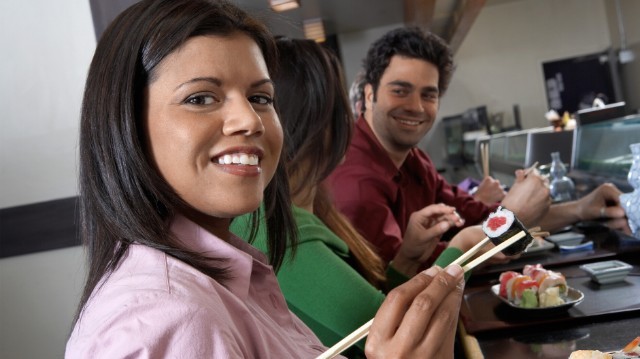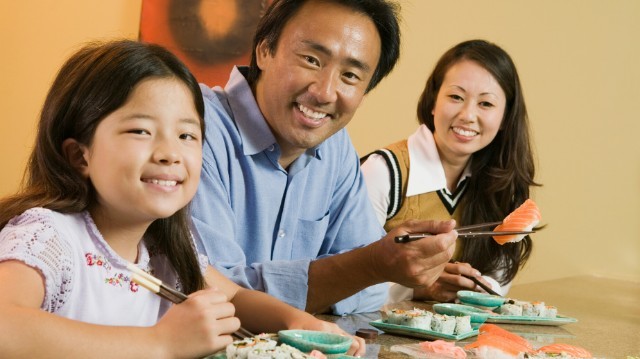I love Japanese food, and I’m sure that many of you reading this also enjoy well-known Japanese staples such as sushi, ramen, sashimi and so on. If you know how to say delicious in Japanese, then you can complement the chief next time you’re dining on such goodness.
But if you don’t know how to say it yet, then don’t worry because I’m going to go over it in this post and give you some other words that you might find beneficial to learn and remember.
The only thing I won’t be able to help you out with is the hunger you might feel from looking at all of these pictures of delicious food!
How To Say Delicious In Japanese
So there you are sitting at the table when your food arrives. You pick up the first sushi roll with your chopsticks, dip it in soy sauce and then put it into your mouth and boy is it good!
The Japanese word for delicious is:
- おいしい!
- oishii!
- Delicious!
This is all that you need to say in order to convey your positive feelings about the food that you’re eating. If things are a little more formal, such as at a business lunch, then you can add the polite です (desu) on to the end of it and say おいしいです (oishii desu).
When you’re reading Japanese, it’s common for this word to be written entirely in hiragana, but that doesn’t mean that you’ll never see it in kanji. In fact, it would be a good idea to learn the kanji for it for those times when you encounter them.
- 美味しい。
- oishii.
- Delicious.
Another phrase that you might want to learn is how to say that something “looks delicious” when you see it. This might be when the food is brought out to you, when a friends shows you a picture of their meal from the other day, or even when you see the display food that shops put out to make customers hungry.
- 美味しそう!
- oishisou!
- That looks delicious!
In this case, you simply drop the final い and replace it with そう to change it from the statement “it is delicious” which is something you could only declare once you’ve tasted it for yourself, to the “it looks delicious” which is your guess having only seen it so far.
There is also another Japanese word that gets used a lot to say that the food is good.
- うまい!
- umai!
- Delicious!
The word うまい has slightly different connotations than おいしい even though they can both be used to say that your food is good.
The first difference is that うまい brings with it the idea of “skill” to the meal. So if a meal was created and presented at a high skill level, then it might be more appropriate for you to say うまい.
The other difference is that うまい tends to get used more by men, whereas おいしい gets used more by women and children. Having said that, I’ve heard it both ways on these words so it’s not really that big of a deal which one you use.
Similar to before, you can drop the final い and add そう to say that something “looks good” with うまそう (umasou).
Finally, there are the kanji that get used for うまい. Unfortionately, there are a lot of them!
Here’s the complete list that I pulled from jisho.org:
- 上手い
- 美味い
- 旨い
- 巧い
- 甘い
- 美い
All of these are read as 「うまい」 and mean the same thing. Having read a lot of books and articles in Japanese, I can safety say that I’ve seen all of them used at some point. Sometimes it depends on the author and the time frame that something was written in, such as back in the 1980s, but the point is that you’ll want to at least be familiar with all of them.
Saying Something Is Your Favorite
Maybe you’re with some friends and they ask you want you would like to eat for dinner. In situations like these you can let them know what your favorite food is by using the adjective 好きな (sukina).
- 好きな食べ物は寿司です。
- sukina tabemono wa sushi desu.
- My favorite food is sushi.
Sometimes you’ll see the word 一番 (ichiban) added into the mix which means “number one” or “the top; the best; the most” when a person asks you about your favorite meal or drink.
- 一番好きな飲み物は?
- ichiban sukina nomimono wa?
- (What is) your number one, favorite drink?
This adds a little extra “ompf” to your sentence letting a person know just how much you like something.
Proper Table Manners

When eating in Japan there are a couple of common table manner things to keep in mind. The first one is of course the set phrase いただきます (itadakimasu) that everyone says together before digging into the food.
Other common courtesy things are refilling other people’s drinks for them, and letting them refill your drink.
Not eating directly from the shared plates, but rather transferring food from the communal plate to your private plate. Not passing food from one pair of chopstick to someone else’s chopsticks (put it on their plate instead).
Not sticking and leaving your chopsticks vertically into food such as the rice. This resembles incense at a funeral and is seen as a bad thing.
Saying things like “the food looks good” is also a nice way to complement whoever prepared the food for you.
And of course, remember to thank people for the food. There are a couple of ways to do so, and we’ll cover them in the next section.
Thanking People For The Food
There are several ways to say thank you in Japanese, but there is a particular one that gets used at the end of meals.
- ごちそうさまでした!
- gochi sou sama deshita!
- Thank you for the meal!
This phrase means something along the lines of “it was a feast” when translated literally, but the important thing to remember is that this is the phrase used to thank the host for the food and that you enjoyed it.
You might also use phrases to directly tell them the food “was delicious” after you’ve finished eating it.
- 美味しかったです!
- oishikatta desu!
- I was delicious!
The main thing to remember is simply to show your appreciation for their hard work.
Now I’m Hungry!
Talking about Japanese food has got me hungry, and it’s only 9:00am where I’m at!
Be sure to give these phrases a try the next time you’re at a Japanese restaurant or the next time you’re eating with Japanese friends. You’re sure to get some happy smiles back in return!
Now I want to hear from you! Leave a comment below and share your opinion!
Further Resources for Learning Japanese:
#3 Get My eBook (Secrets to Learning Japanese) for Free

またね!
